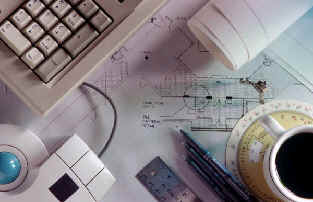A major effort by AutoDesk is the integration of computer-aided drafting (CAD) and geographic information systems (GIS).The first question is why would you want to do this and better yet, who would want to do this?
In many ways CAD and GIS are like oil and water.The CAD people see
their work as engineering-based with high precision placement and accurate
measurement.They view GIS as neither precise nor accurate.The GIS people
see their work as larger scale (who wants a map at 1:40 or 1:20?) and cartographic
in nature rather than pure engineering.It is not that GIS-ers do not want
the accuracy; it is just a lot harder to do over large geographies.

There is also the issue of component geography.GIS is about points,
lines and polygons; it is about imagery and coordinate systems using color
to convey large amounts of information, such as cities, towns rivers, political
boundaries and relief to show geographical perspective.CAD is mostly about
points and lines.Both have attributes and layers; they just treat them
differently and store them differently.
Why you would want to integrate the two? Well a lot of this is driven by elements of Homeland Security where people want to know where things are as well as the details about them.There is also something to be said about have similar files structures, especially if you were going to store these files in a central database.
If you had street centerline files that were accurate within 6 inches (CAD based) and could move them into GIS, then web based map servers could provide local governments and other users with solid infrastructure, assuming all the related files could come along too.This provides a compelling argument for products like MapGuide.
Think about the collaboration of private enterprise with all their files on building, plants and other geographical placements with local government (already done to some degree in Hamilton County, OH and others).
The logic of a map in the first place is to see more than you can as an individual from any vantage point.Imagine a map that drills down to the footprint of buildings, geo-referenced CAD files so you can see the structure, components as well as the visualization of what actually exists in geography.While that exists today, it isn't very seamless to construct.
Questions of a Real Estate nature could be answered on line.Where is the water line? How about the parcel map and deed? What about the slope and other terrain aspects of the property? All of these could be geo-referenced and placed accurately on the map if CAD and GIS were integrated.
One of the companies that are doing this for the Facilities Management (FM) field is OSIS - Online Spatial Information Systems in Calgary.(http://www.idisis.com) They are using a combination of MapGuide, AutoCAD, ARCHIBUS/FM, Cold Fusion and Flash to create an environment that has maps, CAD files that are geo-referenced, imagery, reports and graphics.Flash provides animation.
The result is to be able to see your facilities, where they are, have access to the detail drawings and all the historical information about facility maintenance or other characteristics.This product also takes you down to the furniture and equipment details, show moving plans (rooms from - to) and the existing infrastructure, such as the electrical distribution and existing computer network availability.
With that level of detail, it is a very short step from FM to Emergency Management.
This is some very interesting software and it is indicative of an evolution to greater detail with more precise detail and distributed access.
Perhaps soon we will see maps that are almost the physical geography itself, rather than just a representation of that geography.